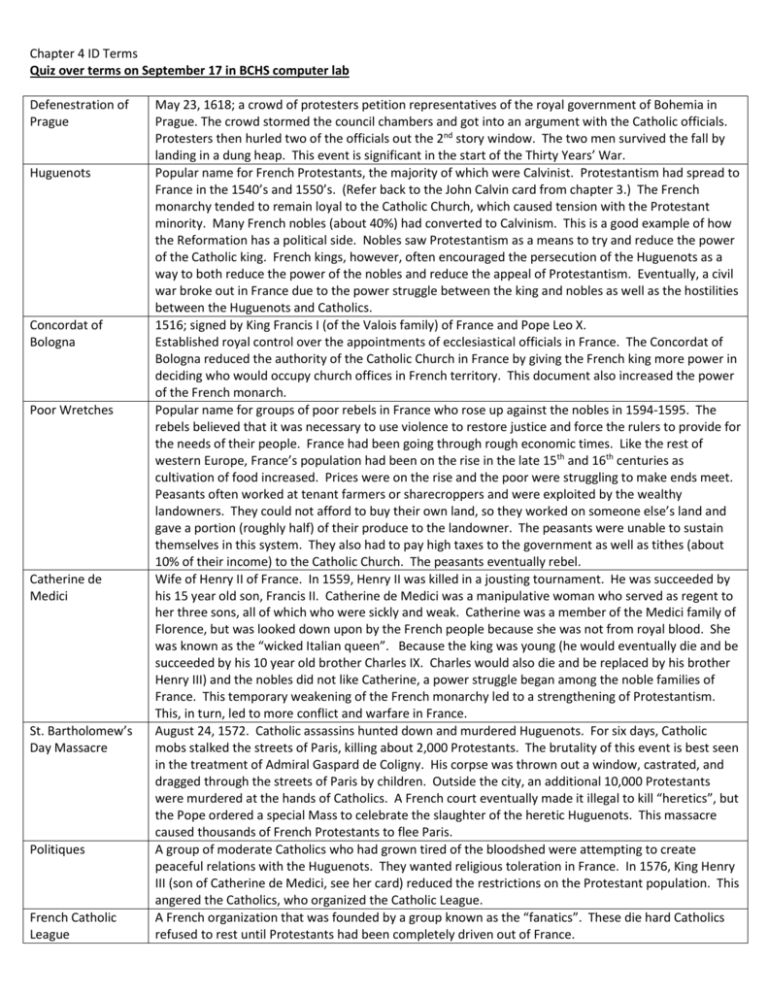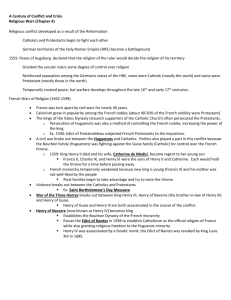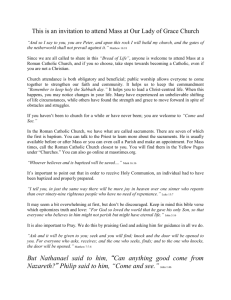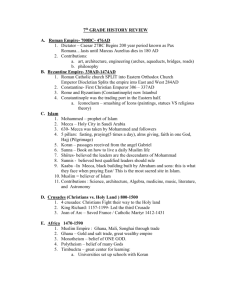Defenestration of Prague
advertisement

Chapter 4 ID Terms Quiz over terms on September 17 in BCHS computer lab Defenestration of Prague Huguenots Concordat of Bologna Poor Wretches Catherine de Medici St. Bartholomew’s Day Massacre Politiques French Catholic League May 23, 1618; a crowd of protesters petition representatives of the royal government of Bohemia in Prague. The crowd stormed the council chambers and got into an argument with the Catholic officials. Protesters then hurled two of the officials out the 2nd story window. The two men survived the fall by landing in a dung heap. This event is significant in the start of the Thirty Years’ War. Popular name for French Protestants, the majority of which were Calvinist. Protestantism had spread to France in the 1540’s and 1550’s. (Refer back to the John Calvin card from chapter 3.) The French monarchy tended to remain loyal to the Catholic Church, which caused tension with the Protestant minority. Many French nobles (about 40%) had converted to Calvinism. This is a good example of how the Reformation has a political side. Nobles saw Protestantism as a means to try and reduce the power of the Catholic king. French kings, however, often encouraged the persecution of the Huguenots as a way to both reduce the power of the nobles and reduce the appeal of Protestantism. Eventually, a civil war broke out in France due to the power struggle between the king and nobles as well as the hostilities between the Huguenots and Catholics. 1516; signed by King Francis I (of the Valois family) of France and Pope Leo X. Established royal control over the appointments of ecclesiastical officials in France. The Concordat of Bologna reduced the authority of the Catholic Church in France by giving the French king more power in deciding who would occupy church offices in French territory. This document also increased the power of the French monarch. Popular name for groups of poor rebels in France who rose up against the nobles in 1594-1595. The rebels believed that it was necessary to use violence to restore justice and force the rulers to provide for the needs of their people. France had been going through rough economic times. Like the rest of western Europe, France’s population had been on the rise in the late 15th and 16th centuries as cultivation of food increased. Prices were on the rise and the poor were struggling to make ends meet. Peasants often worked at tenant farmers or sharecroppers and were exploited by the wealthy landowners. They could not afford to buy their own land, so they worked on someone else’s land and gave a portion (roughly half) of their produce to the landowner. The peasants were unable to sustain themselves in this system. They also had to pay high taxes to the government as well as tithes (about 10% of their income) to the Catholic Church. The peasants eventually rebel. Wife of Henry II of France. In 1559, Henry II was killed in a jousting tournament. He was succeeded by his 15 year old son, Francis II. Catherine de Medici was a manipulative woman who served as regent to her three sons, all of which who were sickly and weak. Catherine was a member of the Medici family of Florence, but was looked down upon by the French people because she was not from royal blood. She was known as the “wicked Italian queen”. Because the king was young (he would eventually die and be succeeded by his 10 year old brother Charles IX. Charles would also die and be replaced by his brother Henry III) and the nobles did not like Catherine, a power struggle began among the noble families of France. This temporary weakening of the French monarchy led to a strengthening of Protestantism. This, in turn, led to more conflict and warfare in France. August 24, 1572. Catholic assassins hunted down and murdered Huguenots. For six days, Catholic mobs stalked the streets of Paris, killing about 2,000 Protestants. The brutality of this event is best seen in the treatment of Admiral Gaspard de Coligny. His corpse was thrown out a window, castrated, and dragged through the streets of Paris by children. Outside the city, an additional 10,000 Protestants were murdered at the hands of Catholics. A French court eventually made it illegal to kill “heretics”, but the Pope ordered a special Mass to celebrate the slaughter of the heretic Huguenots. This massacre caused thousands of French Protestants to flee Paris. A group of moderate Catholics who had grown tired of the bloodshed were attempting to create peaceful relations with the Huguenots. They wanted religious toleration in France. In 1576, King Henry III (son of Catherine de Medici, see her card) reduced the restrictions on the Protestant population. This angered the Catholics, who organized the Catholic League. A French organization that was founded by a group known as the “fanatics”. These die hard Catholics refused to rest until Protestants had been completely driven out of France. Chapter 4 ID Terms Quiz over terms on September 17 in BCHS computer lab Henry of Navarre (IV) War of the 3 Henrys Edict of Nantes Cardinal Richelieu Thirty Year’s War Holy Roman Empire/Emperor 1553-1610; Husband of Margaret Valois, the daughter of Catherin de Medici and sister to kings Francis II, Charles IX, and Henry III of France. Henry was a Huguenot from the Bourbon family. Henry of Navarre became heir to the French throne in 1584. Having a background in both faiths (he was Protestant, converted to Catholicism, and then back to Protestantism), Henry was a supporter of religious toleration. He switched his religion several times, which angered the French people. He became king in 1589 after a Catholic monk assassinated King Henry III. Henry of Navarre became known as Henry IV and faced much resistance as king due to religious conflict. Henry IV of Navarre survived 9 assassination attempts. In 1598, he issued the Edict of Nantes (see card for details). Henry eventually sought an annulment from Margaret and ended up marrying Marie de Medici, a relative of Catherine de Medici. He and Marie had three children. Henry was a womanizer who produced 6 illegitimate children with three different mistresses. He was also a patron of architectural projects in Paris and known for his prowess on the battlefield. Henry IV helped to increase France’s power in Europe. He increased the power of the monarchy and strengthened France’s economy by encouraging textile manufacturing. In 1610, Henry died as a result of a 10th assassination attempt. He was stabbed three times by a monk. Henry III (King of France and son of Catherine de Medici) allied with Henry of Navarre against Henry, duke of Guise. The Guise family wanted to take over the throne and drive Protestantism out of France. Eventually, Henry III switched sides of the conflict and allied with Henry Guise. Henry of Navarre was eventually able to defeat the combined forces of the other two Henrys through the strategic use of artillery and cavalry. Henry III then switches back to support Henry of Navarre and had Henry Guise murdered. The War of the 3 Henrys disrupted France and led to much bloodshed. Issued by King Henry IV (formerly Henry of Navarre) in 1598. Declared Catholicism to be the official religion of France, but granted Protestants the right to worship. The Edict granted religious tolerance for the Huguenots of France. Served as the advisor to King Louis XIII of France. He divided France into 32 districts and appointed governors to each district. Those governors were loyal to himself and the king. Richelieu encouraged King Louis XIII to destroy Huguenot strongholds in France, while still allowing religious tolerance. He advised Louis XIII to ally with the German Protestants, the English and Dutch against the Spanish and Holy Roman Emperor in the Thirty Years’ War. Richelieu helped to strengthen the French monarchy and helped to lay the foundations for the development of the absolute monarchy, which reaches its height under Louis XIV. 1618-1648; major military conflict caused by religious conflict and dynastic rivalries. In Bohemia (a German state in the Holy Roman Empire), the Holy Roman Emperor had placed restrictions on Protestant worship. Protestants banned together and stormed the government chambers in what is known as the “Defenestration of Prague” (see card). Bohemia went into full revolt and created a provisional government. In 1619, Frederick, a Protestant and elector of Palatinate (see card), was offered a position as the ruler of Bohemia; he accepted. Holy Roman Emperor Ferdinand was upset by this. He turned to Spain for help fighting the Protestants of Bohemia. Both sides raised their armies. The situation escalated into a 30 year long war that devastated the German states. France, England, and the Netherlands allied with the Protestants while Spain backed the Holy Roman Emperor and Catholics of Germany. The war went through various stages with periods of Danish and Swedish intervention. The latter stages of the war were characterized by dynastic rivalry between Catholic France and the Hapsburg family of Spain and the Holy Roman Empire. The Thirty Years’ War, combined with the other religious wars, had a huge impact on the demography of Europe, causing a temporary decline in population following the population growth of the sixteenth century. Approximately 4 million people living in the Holy Roman Empire lost their lives as a result of religious warfare. Some towns lost as much as ¾ of their population while rural areas of Germany suffered a 40% decline in population. Farms were destroyed and/or abandoned. The Holy Roman Empire was a loose confederation of states in central and northern Europe. The states ranged in size and power with Austria (ruled by Hapsburgs) being among the largest and most powerful. Most of the territories of the Holy Roman Empire were Germanic states and had their own ruling Chapter 4 ID Terms Quiz over terms on September 17 in BCHS computer lab families (German princes). Some of the territories (mostly the northern states) were Protestant, while others (largely in the south) remained Catholic. Religious conflict was common during the 1500’s. The Peace of Augsburg (see card from Ch. 3) helped to restore temporary peace, but also reinforced divisions within German states. Emperor Ferdinand II Frederick, the Elector of Palatinate Albert Wallenstein Gustavus Adolphus Treaty of Westphalia The Holy Roman Emperor was an elected office. Seven electors were charged with the task of choosing who would serve as the Holy Roman Emperor. Most of the time, the emperor was chosen from the Hapsburgs of Austria, a family with strong Catholic ties (making them enemies of the Protestant princes) and connections to the throne of Spain, the Netherlands, and other territories in France, Italy, etc. The Holy Roman Emperor was a prestigious position, but the emperor was limited in his power due to conflict and competition with the German Princes. Holy Roman Emperor during the Thirty Years’ War. Ferdinand was a member of the Hapsburg family and a Catholic. A Protestant who served as one of the 7 electors charged with the task of electing the Holy Roman Emperor. In 1619, Frederick was asked to become ruler of Bohemia, a German territory that had rebelled against the Holy Roman Emperor (Ferdinand II). Frederick led the Protestant forces during the Thirty Years’ War. His position of Elector was transferred to Maximilian I, a Catholic from Bavaria. 583-1634, a Bohemian noble who was raised as a Lutheran but converted to Catholicism. He became a well-known military man. He was hired by Emperor Ferdinand II to raise and lead the Catholic army during the Thirty Years’ War. He was very successful, but was eventually dismissed from his command due to the Catholic’s inability to trust him. His men would loot and destroy all lands they crossed, including those of his supposed allies. He was also suspected of attempting to aid the Protestants and even attempting to join forces with them. In 1634, Emperor Ferdinand ordered Wallenstein executed. Refer to page 151 of your book for other interesting facts regarding Wallenstein, including his order to have all cats and dogs in town killed….. King of Sweden from 1611-1632. He was a Lutheran who intervened in the Thirty Years’ War in order to aid the Protestants. Known as the “Lion of the North”. He was both an accomplished military man as well as a cultured gentleman. His strategic use of the military helped him win battles against Catholics in Poland and helped to turn the tide of war in favor of the Protestants for a time. In 1634, the Spanish army defeated the Swedes. Peace treaty signed at the end of the Thirty Years’ War in 1648. Two hundred rulers and thousands of diplomats attended the conference where the treaty was drafted. The treaty redrew the map of Europe to create the Dutch United Provinces and Switzerland and decide which rulers would control which territories. The treaty ended the religious wars of Europe by encouraging religious toleration. The autonomy of the German states of the Holy Roman Empire was reaffirmed. France emerged from the war with a stronger monarchy thanks to the policies of Louis XIII. Following the Thirty Year’s War and the Treaty of Westphalia, the monarchs turn to absolutism.







